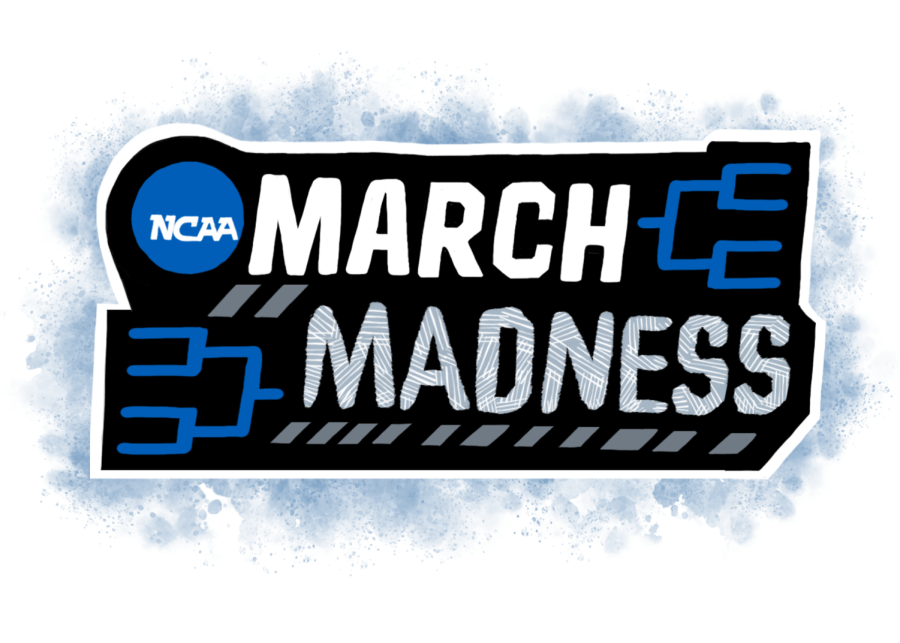‘It’s not normal basketball’: March Madness is here
An illustration of the March Madness brackets. March Madness is the most prominent college basketball competition in the year, concluding the season in a single-elimination style playoff tournament.
March 8, 2023
The month of March traditionally marks the transition of turbulent winter weather into the warmer months of spring. But despite this seasonal change inviting us into the outdoors to appreciate a revival of nature, hundreds of thousands of people around the nation will be sitting on the edges of their seats in jam-packed arenas, engrossed by ongoing college basketball matches. Millions more will be tuning in through online broadcasts, congregating with fellow fans at watch parties or using any sliver of idle time to catch part of a game, adamant on not missing “the moment.” This is the March Madness effect.
March Madness is the most prominent college basketball competition in the year, concluding the season in a single-elimination style playoff tournament. 68 of the best Division 1 college basketball programs will be chosen based on a variety of factors, such as their regular season records, quality of wins, and statistical rankings, to determine their eligibility. This occurs on March 12, also known as Selection Sunday. The National Collegiate Athletic Association (NCAA) then releases the full schedule and seeding for the tournament, often leading fans and analysts to fill out predicted brackets and announce their projections. Seven rounds of basketball games around the nation will be played through approximately three weeks starting on March 14, with the NCAA National Championship game on April 3 at the NRG Stadium in Houston, Texas.

Upper school biology teacher Dr. Matthew Harley first cemented his interest in college basketball after frequently catching local games at the University of Maryland as a kid. He continued to play basketball in university as well, and to this day is an avid fan of the Maryland Terrapins.
“[March Madness is] certainly something that I always look forward to,” Dr. Harley said. “It’s winter and it’s cold right now, but March Madness is coming. It’s definitely something that can get me through some doldrums at this time of year.”

Varsity boys basketball player Om Tandon (11) began following March Madness when he first started watching University of Southern California (USC) men’s basketball with his dad, who formerly attended USC himself. This time shared with his father gradually paved the way for an interest in all of college basketball, with Om supporting the USC Trojans throughout. This year he also roots for the Saint Mary’s Gaels, which Bay Area native Aidan Mahaney from Campolindo High School plays for. Om offers his perspective on the unique nature of March Madness as a whole.
“My favorite part of March Madness is the unpredictability,” Om said. “With college basketball, there’s not one clear cut [projected] winner, so you don’t know what to predict this year. Every team has their flaws, but every team [also] has their strengths. It’s not normal basketball. There’s a lot of people who don’t get a lot of recognition [but] come onto the stage during March Madness, and there’s a lot of different big plays and buzzer beaters [which] makes it really fun to watch.”

In the past 50 years, there have only been three instances of back-to-back championships by a team, further attesting to the fact that there are no guarantees when it comes to March Madness results. Anything can happen: a major comeback may occur like Brigham Young University (BYU)’s 25 point comeback over Iona in 2012, an underdog team may exceed expectations and go on an impressive winning streak like Loyola Chicago’s run in 2018 or maybe a powerhouse team disappoints and loses in an early round like Michigan State’s first round exit in 2016 to Middle Tennessee State. The intensity of March Madness is further magnified when taking into account that the tournament is run in a single-elimination fashion, meaning that one loss will knock a team out of the tournament.
While ultimately the most important game is the final matchup between the last two undefeated teams, many viewers find themselves attracted to the chaotic opening days of March Madness. Eight borderline teams first compete in a small-scale play-in tournament to determine four winning teams that will secure a spot in the overall tournament. Then, the remaining 64 teams all play in the first round from March 16 to March 17, which is closely followed by the second round of games from March 18 to March 19. In the span of two days, 32 teams are eliminated.

Dr. Harley especially enjoys the exciting start to March Madness, during which there are expected to be numerous highlights that come with the sheer number of games played by the top teams in the nation. These beginning matches set the stage for what’s more to come as teams progress and get narrowed down to the sweet sixteen, elite eight, final four, then the inevitable national championship.“The first four days [are] the best four consecutive days of sports,” Dr. Harley said. “It’s the first two rounds of March Madness — it’s seeing some incredible upsets. A couple of years ago, for the first time, we had a number one seed lose to a number 16 [seed]. Always having games on and being able to switch channels and see multiple games, and having some that [are] ending in buzzer beaters is just so exciting.”


















![“[Building nerf blasters] became this outlet of creativity for me that hasn't been matched by anything else. The process [of] making a build complete to your desire is such a painstakingly difficult process, but I've had to learn from [the skills needed from] soldering to proper painting. There's so many different options for everything, if you think about it, it exists. The best part is [that] if it doesn't exist, you can build it yourself," Ishaan Parate said.](https://harkeraquila.com/wp-content/uploads/2022/08/DSC_8149-900x604.jpg)




![“When I came into high school, I was ready to be a follower. But DECA was a game changer for me. It helped me overcome my fear of public speaking, and it's played such a major role in who I've become today. To be able to successfully lead a chapter of 150 students, an officer team and be one of the upperclassmen I once really admired is something I'm [really] proud of,” Anvitha Tummala ('21) said.](https://harkeraquila.com/wp-content/uploads/2021/07/Screen-Shot-2021-07-25-at-9.50.05-AM-900x594.png)







![“I think getting up in the morning and having a sense of purpose [is exciting]. I think without a certain amount of drive, life is kind of obsolete and mundane, and I think having that every single day is what makes each day unique and kind of makes life exciting,” Neymika Jain (12) said.](https://harkeraquila.com/wp-content/uploads/2017/06/Screen-Shot-2017-06-03-at-4.54.16-PM.png)








![“My slogan is ‘slow feet, don’t eat, and I’m hungry.’ You need to run fast to get where you are–you aren't going to get those championships if you aren't fast,” Angel Cervantes (12) said. “I want to do well in school on my tests and in track and win championships for my team. I live by that, [and] I can do that anywhere: in the classroom or on the field.”](https://harkeraquila.com/wp-content/uploads/2018/06/DSC5146-900x601.jpg)
![“[Volleyball has] taught me how to fall correctly, and another thing it taught is that you don’t have to be the best at something to be good at it. If you just hit the ball in a smart way, then it still scores points and you’re good at it. You could be a background player and still make a much bigger impact on the team than you would think,” Anya Gert (’20) said.](https://harkeraquila.com/wp-content/uploads/2020/06/AnnaGert_JinTuan_HoHPhotoEdited-600x900.jpeg)

![“I'm not nearly there yet, but [my confidence has] definitely been getting better since I was pretty shy and timid coming into Harker my freshman year. I know that there's a lot of people that are really confident in what they do, and I really admire them. Everyone's so driven and that has really pushed me to kind of try to find my own place in high school and be more confident,” Alyssa Huang (’20) said.](https://harkeraquila.com/wp-content/uploads/2020/06/AlyssaHuang_EmilyChen_HoHPhoto-900x749.jpeg)












